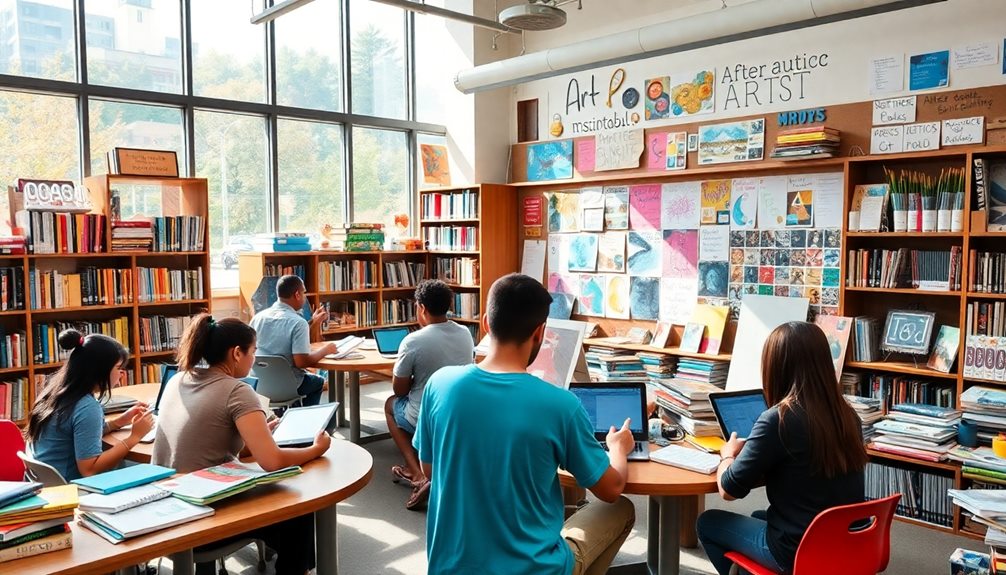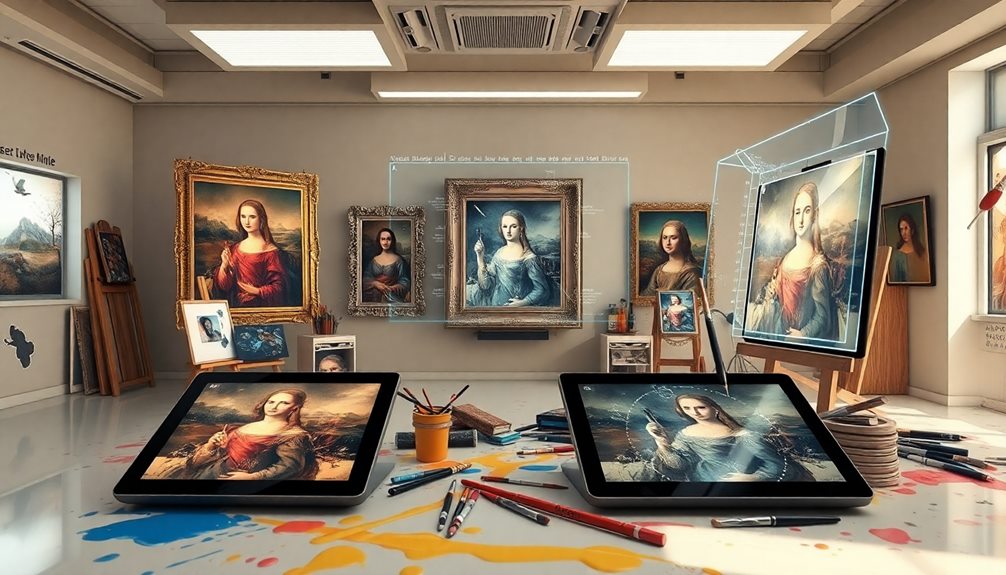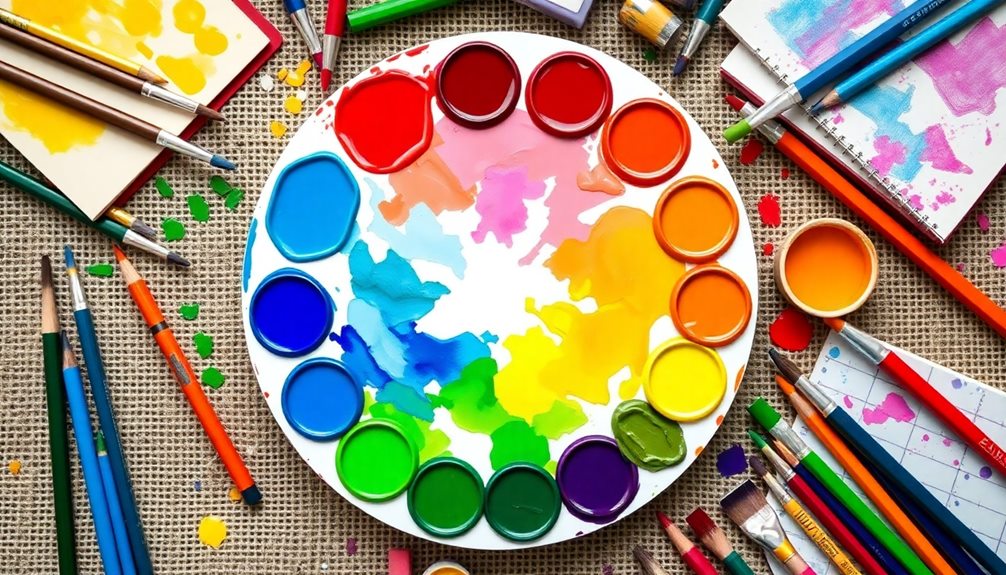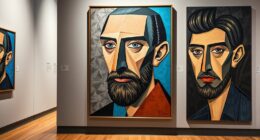As an art student, you've got a treasure trove of resources at your fingertips. Start with platforms like the Getty Virtual Library and the Mets Collection for extensive art history. Explore Google Arts & Culture for virtual exhibitions, or find inspiration on educational channels like MoMAvideos and Smarthistory. Don't forget your university library's vast archives and scholarship opportunities provided by organizations like the National Endowment for the Arts. Engaging with community arts programs can foster skill development and creativity. There's so much more out there to discover, so be sure to explore further and uncover additional gems.
Key Takeaways
- Utilize the Mets Collection and Getty Virtual Library for extensive art history research and high-resolution images.
- Explore Google Art Project for virtual access to over 40,000 artworks from museums worldwide.
- Take advantage of educational YouTube channels like MoMAvideos and The Art Assignment for insightful lectures and hands-on projects.
- Access university library resources for fundamental materials and guides to navigate art history topics effectively.
- Stay informed about scholarships and grants specifically for art students through organizations like the National Endowment for the Arts.
Key Resources for Art Research
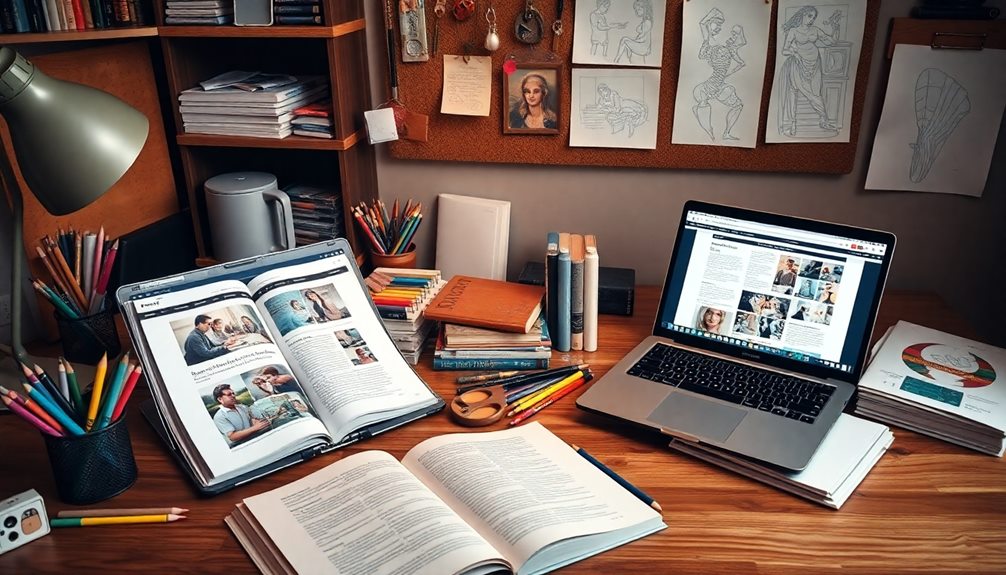
When diving into art research, you're equipped with a wealth of key resources that can greatly enhance your understanding and exploration. The Mets collection offers an extensive look at global art history, organized into chronological, geographical, and thematic categories. This thorough educational resource is essential for anyone seeking to deepen their knowledge of art across different cultures and periods.
Another invaluable tool is the Getty Virtual Library, where you can access a vast range of digital titles from the Getty Publications Archives. This resource appreciably boosts your scholarly research capabilities in art history.
Furthermore, the Chicago Art Institute Online Scholarly Catalogues provide high-resolution images paired with in-depth curatorial research, making them perfect for art students and researchers.
Don't forget about Smarthistory, the official art history provider for Khan Academy. It offers an array of videos and articles that support diverse learners in grasping art and cultural heritage.
Digital Art Platforms
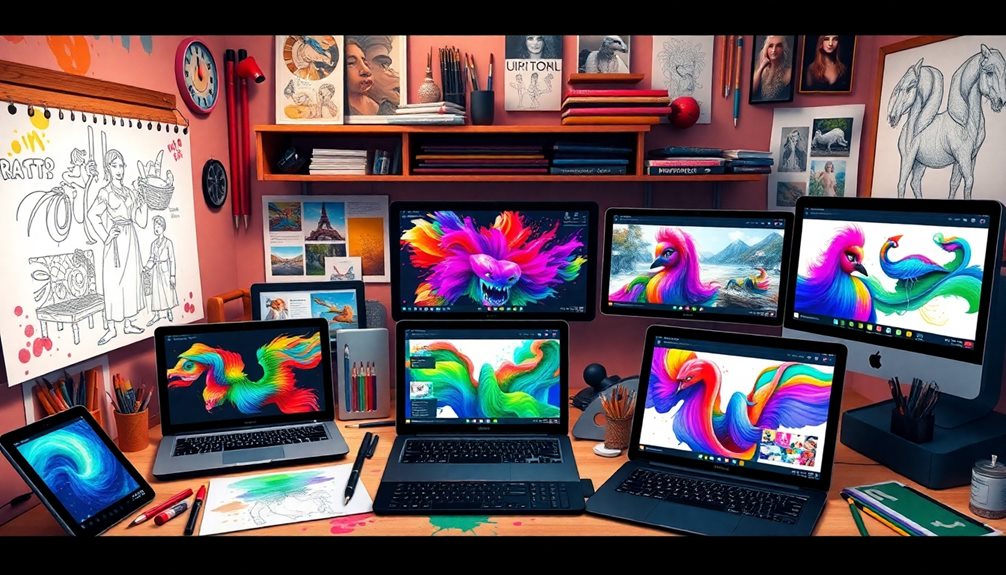
Exploring digital art platforms opens up a world of creativity and accessibility for art students and enthusiasts alike. These platforms provide a unique way to engage with visual arts, offering resources that are freely available to anyone with an internet connection.
For instance, the Google Art Project features over 40,000 high-resolution images from museums across more than 40 countries, allowing you to explore diverse art collections virtually.
With the Gigapixel format on certain platforms, you can zoom in on intricate details within artworks, enhancing your online viewing experience. You're not just a passive observer; you can create and share personal virtual art galleries through the Google Art Project, fostering community engagement and appreciation for art.
Additionally, the Walker Art Center provides insightful art talks and collection overviews, giving you deeper insights into contemporary art practices.
If you're looking to expand your horizons, Google Street View technology lets you virtually explore landmark interiors, such as the Palace of Versailles, bringing significant cultural sites directly to your screen.
Embrace these digital art platforms to enhance your understanding and enjoyment of the visual arts.
Educational YouTube Channels
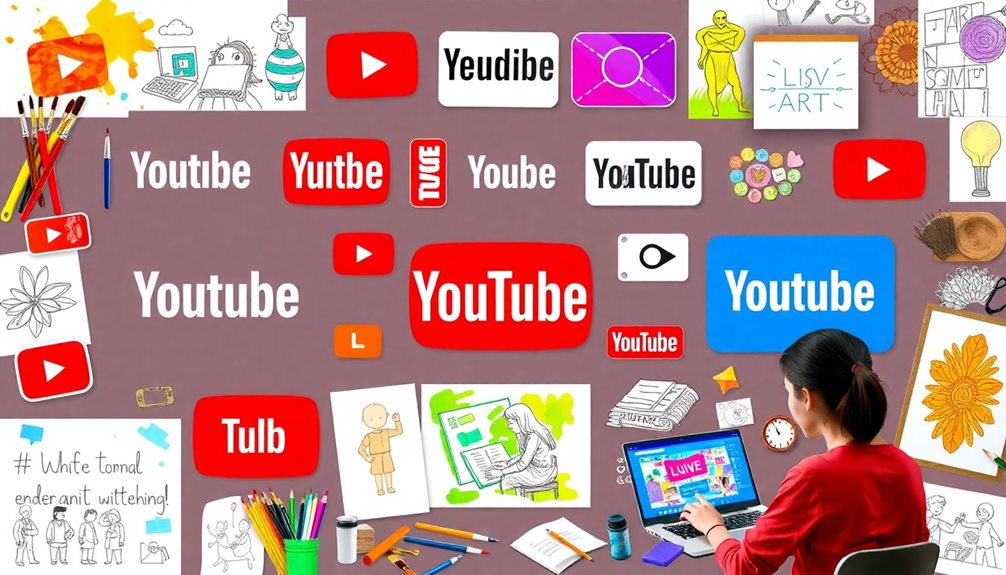
Tuning into educational YouTube channels can greatly enrich your art journey, offering a wealth of knowledge and inspiration. Channels like MoMAvideos provide high-quality lectures and interpretations of specific artworks, giving you insights into both contemporary and historical art perspectives.
If you're looking to create, The Art Assignment presents weekly projects developed by working artists, encouraging you to engage in hands-on art creation while exploring various artistic concepts and techniques.
For those interested in the cutting edge of art and culture, Artists Space has been spotlighting emerging ideas and innovative practices since 1972. Their discussions and interviews can deepen your understanding of contemporary art.
Meanwhile, the Walker Art Center offers interviews with artists and discussions about current exhibits, helping you grasp contemporary art trends and the creative process.
Lastly, don't overlook the Google Art Project, which features art talks that enhance your appreciation of cultural initiatives and the history of artworks.
Research Tools and Guides

After enhancing your knowledge through educational YouTube channels, it's time to harness valuable research tools and guides that can support your artistic studies.
One of the best places to start is your university's library resources. The UNO library offers access to a wide range of fundamental art and art history materials, aiding you in your research endeavors. Use thorough guides provided by the library to navigate various art history topics and locate relevant literature and artworks effectively.
Collaboration with institutions also plays a vital role in enhancing your research experience. This collaboration guarantees that you can access updated resources that meet national standards for art education.
Don't overlook specialized online platforms like the Getty Virtual Library and the Chicago Art Institute Online Scholarly Catalogues; these provide in-depth curatorial research and high-resolution images critical for your art analysis.
Online Learning Platforms

As you immerse yourself in the world of online learning platforms, you'll discover a wealth of resources tailored to enhance your artistic skills. Platforms like Sparketh offer over 1,000 bite-sized video art lessons, allowing you to learn at your own pace, regardless of your skill level.
If you crave hands-on experience, The Art Assignment provides weekly projects developed by working artists, pushing you to explore your creativity.
Google Arts & Culture takes you beyond traditional learning, offering access to virtual exhibitions and art talks that connect you with cultural initiatives worldwide. This exposure not only broadens your perspective but also deepens your understanding of global art movements.
For those interested in contemporary art, MoMAvideos features lectures and interpretations of specific artworks, enriching your appreciation through educational content.
Moreover, many online courses cover a diverse range of art techniques, from digital to traditional arts, making art education more accessible than ever.
These platforms empower you to cultivate your artistic talents, engage with the art community, and expand your creative horizons—all from the comfort of your home.
Immerse yourself and discover the endless opportunities waiting for you!
Scholarships and Grants
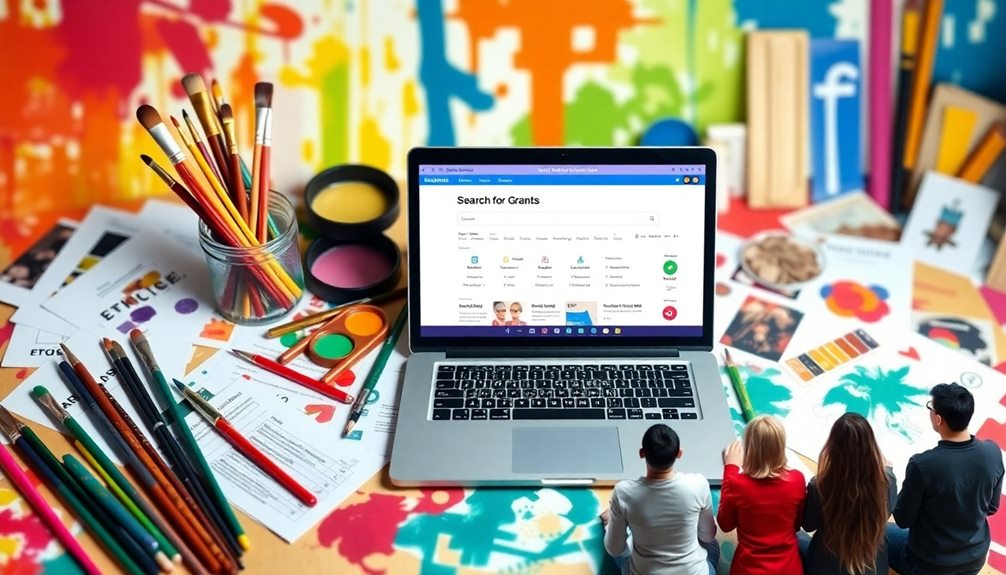
Maneuvering the landscape of scholarships and grants can open doors for your artistic journey.
With countless funding opportunities available, including local arts grants and national programs, it's essential to stay informed and proactive.
Available Funding Opportunities
Securing funding for your art education can be a transformative experience, opening doors to new opportunities and creative exploration. Various organizations offer funding opportunities that can support your artistic journey. For instance, the National Endowment for the Arts provides grants aimed at fostering innovation within the arts community. Local arts organizations frequently offer scholarships that encourage young talent to develop their skills.
Here's a quick overview of some notable funding opportunities:
| Organization | Type of Funding |
|---|---|
| National Endowment for the Arts | Grants for art projects and individuals |
| College Art Association | Grants and scholarships for graduate students in the visual arts |
| Scholastic Art & Writing Awards | Scholarships for high school students |
| Jack Kent Cooke Foundation | Funding for exceptional students to cover tuition and education-related expenses |
Application Tips and Strategies
Applying for scholarships and grants can greatly enhance your art education, but it requires careful preparation and strategy. Start by researching various organizations that provide funding, like the National Endowment for the Arts and local arts agencies. These entities often offer scholarships specifically for art students, including grants for individual projects.
Make use of online platforms, such as TeenLife, which lists thousands of scholarship opportunities tailored for high school students interested in the arts. This can save you time and help you discover options you mightn't have considered.
Gather all necessary application materials well in advance—think portfolios, letters of recommendation, and personal statements. Many scholarships have strict deadlines and specific requirements, so being organized is key.
Don't forget to leverage community resources like local arts councils; they often have information on scholarships and can guide you through the application process.
Additionally, stay informed about national and regional art competitions, as many of these events also offer scholarships to winners or participants, giving you extra funding opportunities.
Local Arts Grants
Local arts grants play an essential role in supporting artists and art projects within your community. These grants, often provided by community organizations, foundations, and government entities, focus on funding emerging artists and impactful art initiatives. They prioritize projects that enhance community engagement, cultural development, and accessibility to the arts.
Additionally, understanding state tax implications for any funding received can help you manage your finances effectively as you navigate your artistic journey.
When you're considering applying for local arts grants, be prepared to submit a project proposal. This proposal should outline your goals, budget, and the expected impact of your artistic endeavor.
Various organizations, including the National Endowment for the Arts and regional arts councils, offer tailored grant opportunities for specific art disciplines, such as visual arts, performing arts, and literary arts.
Researching local arts grants can lead to funding for not only individual artists but also community art projects and educational programs. By tapping into these resources, you can help foster a vibrant arts culture in your community.
Community Arts Programs
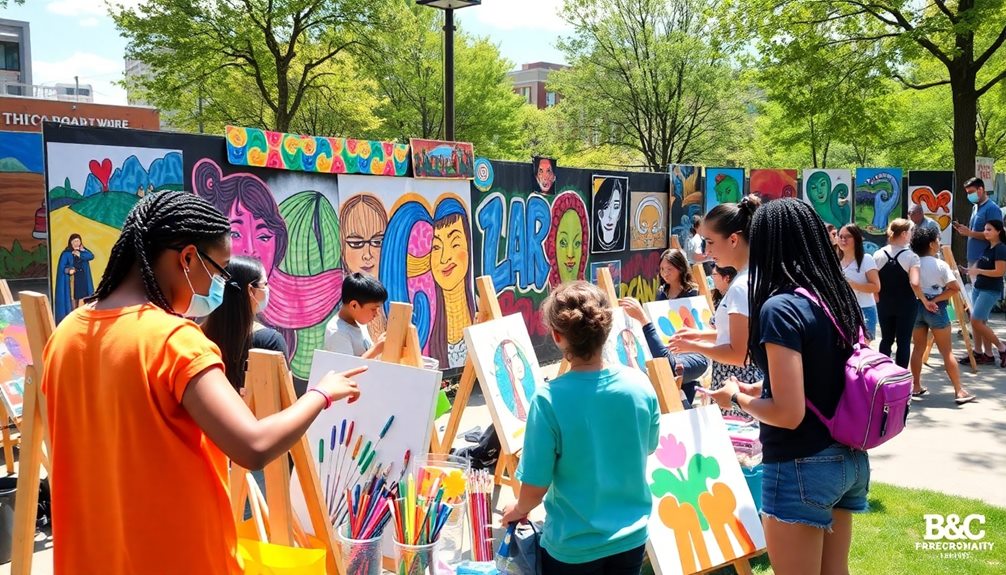
Community arts programs offer you a chance to engage with local art initiatives that promote creativity and collaboration.
By participating in workshops and classes, you can connect with peers and develop your skills in a supportive environment.
These opportunities not only enhance your artistic growth but also help you network within the community and showcase your work.
Local Art Initiatives
In recent years, community arts programs have emerged as crucial hubs for creativity and collaboration. These local community arts programs often provide workshops, classes, and performances that encourage participants of all ages to express themselves and work together. By focusing on fostering engagement, these initiatives showcase local talent and give artists the recognition and feedback they deserve.
Not only do these programs celebrate cultural heritage, but they also enhance social cohesion by bringing together diverse groups for shared artistic experiences and cultural exchanges. When you participate in community arts activities, you're likely to see improvements in your well-being and an increase in civic participation, benefiting both you as an artist and your community.
Local arts organizations frequently offer valuable resources and funding opportunities to support student projects. This support bridges the gap between education and community involvement in the arts, allowing you to thrive creatively while contributing to your surroundings.
Collaborative Creative Opportunities
Artistic growth thrives in environments where collaboration is encouraged. Community arts programs offer you the chance to engage in hands-on experiences through workshops, classes, and collaborative projects.
These initiatives foster creativity and teamwork, allowing you to learn from fellow artists and expand your creative horizons. You'll find that these programs not only enhance your artistic skills but also provide valuable mentorship opportunities, connecting you with local artists and arts organizations.
Participating in community arts programs can considerably boost your personal and professional growth. Many of these initiatives feature exhibitions and competitions, giving you a platform to showcase your work and receive constructive feedback from industry professionals.
This exposure can be pivotal for your development as an artist.
Moreover, involvement in these programs often leads to increased civic engagement. You'll understand the importance of collaboration and community contribution through your artistic efforts.
Technology in Arts
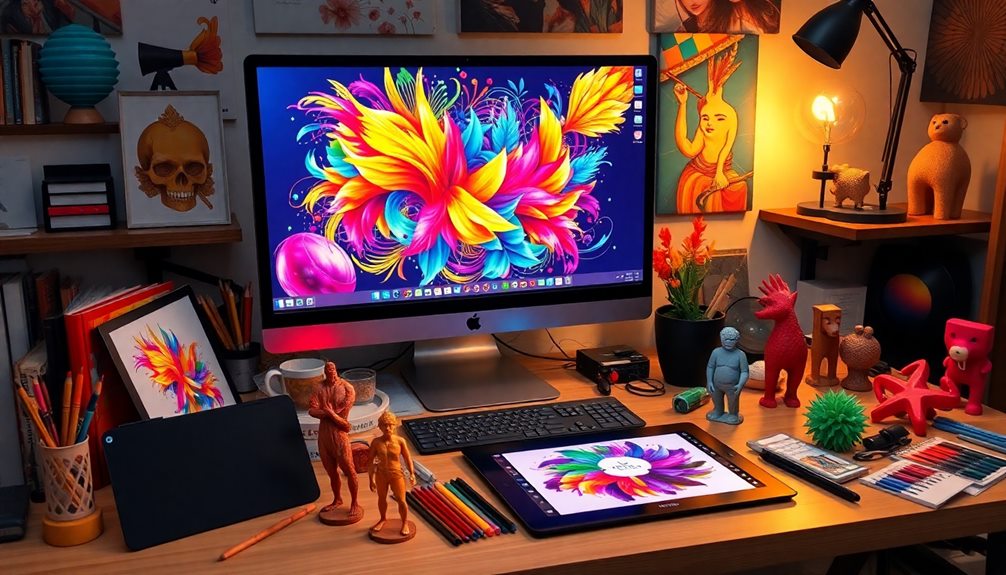
How has technology transformed the way you approach your art?
Today, digital tools and software, like graphic tablets and design programs, are essential for creating and manipulating artwork. This technology opens up new avenues for expression and creativity, allowing you to explore various styles with ease.
Online platforms such as Google Art Project and Walker Art Center enable you to build and share virtual galleries, making art education more accessible than ever.
High-resolution imaging formats, like Gigapixel, let you zoom in on intricate details of artworks, enhancing your ability to analyze and appreciate art in depth.
Additionally, platforms like Sparketh offer bite-sized video lessons tailored to different skill levels, providing a flexible approach to art education.
Art History and Critique Resources
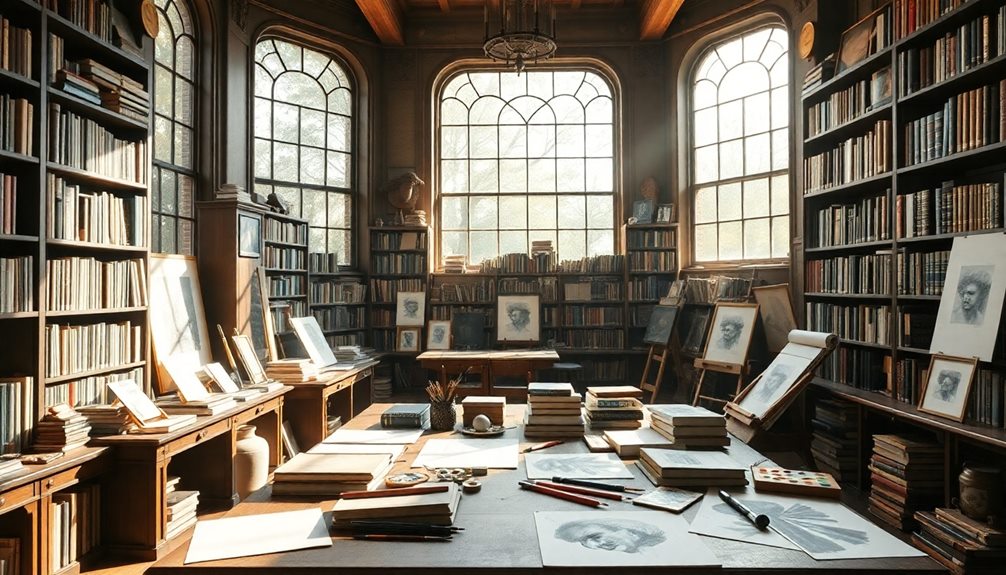
Accessing extensive art history and critique resources can greatly enhance your understanding and appreciation of the field. These resources not only deepen your knowledge but also equip you with the tools to analyze and critique works of art effectively.
Here are three valuable resources to take into account:
- Online Databases: Explore digital archives that house renowned artworks and historical documentation, giving you direct access to significant pieces and their backgrounds.
- Video Lectures: Engage with insights from notable art historians who discuss various art movements, helping you grasp their cultural and historical contexts.
- Interactive Timelines: Visualize the progression of artistic styles and their influences over time, making it easier to understand how art history unfolds.
Additionally, frameworks for conducting art critiques and resources that explain art theory and terminology are essential for developing your critical skills.
Incorporating these elements into your lesson plans will guarantee you're well-prepared to analyze and appreciate the complexities of art. By leveraging these resources, you'll not only enrich your studies but also cultivate a more profound connection to the art world.
Frequently Asked Questions
What Are Some Art Resources?
You can explore the Getty Virtual Library for free access to art literature, immerse yourself in Google Art Project's vast image collection, or utilize Smarthistory's educational videos to enhance your understanding of art and its history.
How to Do Research for Art?
Doing research for art can feel like diving into an endless ocean of creativity! Start by exploring digital libraries, watching engaging videos, and utilizing local resources to uncover rich histories and techniques that inspire your own work.
What Are the Examples of Art Based Research?
Art-based research includes projects like "Art as Research," the National Gallery Technical Bulletin on materials, Smarthistory's analyses, and the Getty Research Institute's exploration of sketchbooks, all enriching your understanding of art and its historical contexts.
What Are the Art Research Methods?
Did you know that over 70% of art historians use visual analysis? You'll find art research methods include visual analysis, field research, archival investigation, comparative analysis, and even quantitative approaches to uncover deeper insights into artworks.
Conclusion
As you navigate the vibrant landscape of art research, let these resources be your guiding stars. Imagine diving into digital platforms, where colors and creativity collide, or exploring YouTube channels that paint knowledge across your canvas. With every scholarship and community program you discover, you're not just learning; you're building a mosaic of skills and connections. Embrace technology's brush, and let it enhance your artistic journey, transforming ideas into masterpieces waiting to emerge.
